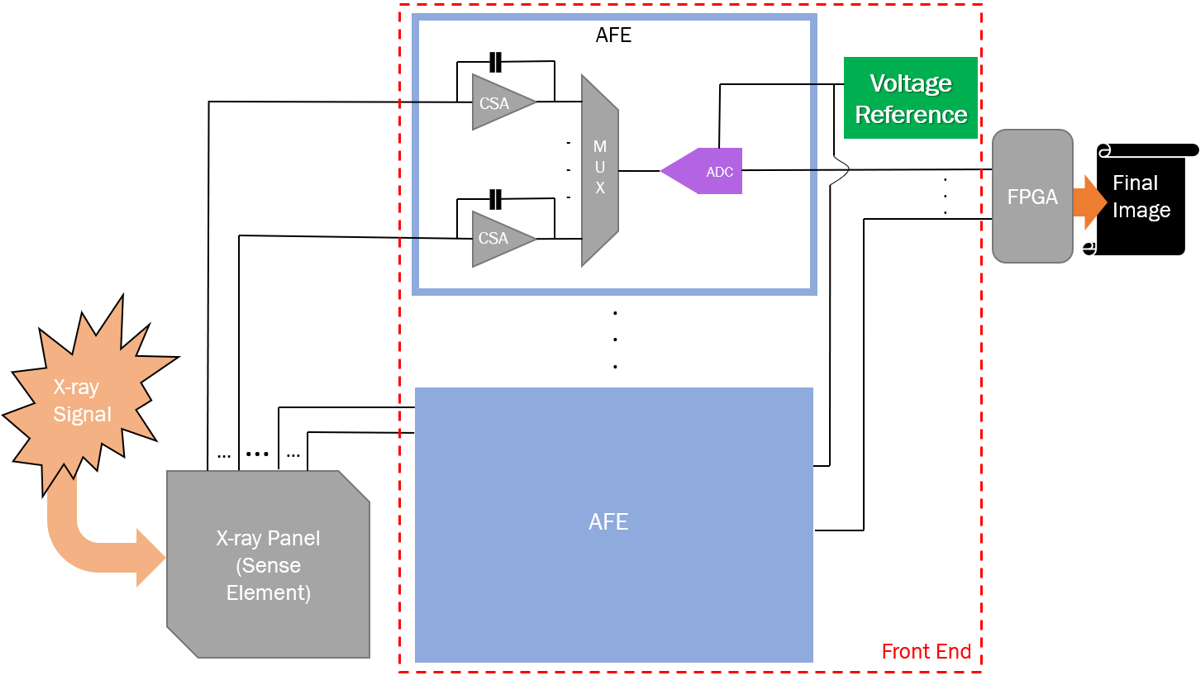SSZTD16 January 2024 REF54 , REF70
One of the most effective ways to improve the image resolution of an X-ray is to reduce the noise present in the front end through careful design of the data-acquisition portions. Using a low-noise series voltage reference in the data-acquisition circuit is one design choice that can lead to lower noise and thus a higher-resolution image.
In this article, I will show how choosing a low noise voltage reference, such as REF54 or REF70, can lead to an improvement in final x-ray image resolution. (To differentiate between a custom integrated circuit and the front end of the X-ray system, any mention of “front end” will refer to the section of the X-ray system that contains a custom integrated circuit, a voltage reference and other devices, and any use of “analog front end (AFE)” will refer to a custom integrated circuit.)
Overview of X-ray imaging operation and system design
In an X-ray system, the AFE receives the generated signal from the X-ray panel. An AFE is a specially designed integrated circuit where data acquisition in the front end takes place. X-ray systems include multiple AFEs that are designed for use in X-ray systems that all use a common voltage reference.
 Figure 1 Simplified block diagram of an
X-ray system front end
Figure 1 Simplified block diagram of an
X-ray system front endThe AFE converts a charge coming from the X-ray panel into a voltage by using a charge-summing amplifier. This voltage is then fed into a multiplexer that provides an analog signal to an analog-to-digital converter (ADC). The ADCs present in the AFE use an external precision voltage reference to provide accurate data conversion.
Once the front end has a digital signal, digital subtraction radiography helps improve the image quality. Digital subtraction radiography compares a scan of the patient and a scan without the patient to remove image flaws. The two images are taken within such a short time frame that the change in temperature is minimal; the X-ray system is in a temperature-controlled environment, after all. However, the process of digital subtraction radiography compensates for image discrepancies caused by any small temperature change in the front end.
Design challenges of implementing a low-noise circuit for X-ray systems
Any noise present in the front end – including in the precision voltage reference and the AFE will propagate through all channels and decrease the final image resolution, leading to a low-quality image.
Choosing an external precision voltage reference with ultra-low noise instead of an internal voltage reference helps improve image resolution and reduces the number of X-rays taken, thus reducing patient and medical professional exposure as well as health care costs.
Table 1 defines a few voltage reference parameters to consider.
| Parameter | Description |
|---|---|
| Flicker noise | Noise present from 0.1Hz to 10Hz |
| Output voltage noise | Noise present from 10Hz to 1kHz |
| Temperature drift | How the output voltage will change with temperature |
Depending on the number of bits or effective number of bits (ENOB) of a digital-to-analog converter or ADC, the parameters in Table 1 can directly affect the gain error and signal-to-noise ratio (SNR) of the circuit. In an X-ray system, a higher gain error translates to decreased image quality. Additionally, the flicker noise of a voltage reference affects the SNR of the ADC.
Equation 1 and Equation 2 show the noise and SNR in an ADC:
From Equation 1, you can see that as the noise of the voltage reference decreases, the total ADC noise decreases. Looking at Equation 2, you can see that decreasing the voltage reference noise leads to an increase in the SNR of the ADC. A higher SNR would lead to a higher ENOB, which is necessary for increased system resolution. Therefore, it is important that the voltage reference noise be much less than the noise of the ADC.
In many cases, opting for an external voltage reference such as TI’s REF70 or REF54 can improve the SNR of the ADC. A precision voltage reference with low noise would be an essential consideration. Table 2 lists the parameters of the REF70 and REF54 series voltage references.
| Parameter | REF70 | REF54 |
|---|---|---|
| Flicker noise | 0.23ppmp-p | 0.45ppmp-p or 0.11ppmp-p with noise reduction capacitor |
| Output voltage noise | 0.35ppmrms | 0.7ppmrms |
| Temperature drift | 2ppm/°C | 0.8ppm/°C |
Lowering the noise present in the analog front end by choosing a low-noise precision voltage reference such as the REF70 or REF54 will increase the SNR in the ADC, which would enable improved image resolution in X-ray systems.
Conclusion
Increasing the quality of X-ray images improves the medical care that people receive. Given the expansive use of X-ray imaging technologies, there are many opportunities for technological advances in this space.
When designing an X-ray system, the ultimate goal is to produce the best image possible. While there are many ways to achieve that, among the most important is choosing the best voltage reference for the design of the front end of the X-ray system. Additionally, having a low-noise circuit design is incredibly important. Choosing a low-noise voltage reference such as the REF54 or REF70 can help improve the resolution of the image and the overall image quality.